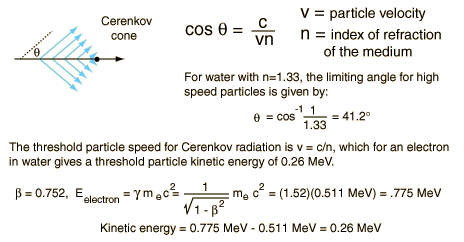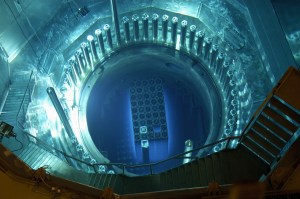It is similar to the bow wave produced by a boat traveling faster than water waves. Cherenkov radiation only occurs if the particle’s speed is higher than the phase velocity of light in the material. Even at high energies, the energy lost by Cherenkov radiation is much less than the other mechanisms (collisions, bremsstrahlung). It is named after Soviet physicist Pavel Alekseyevich Cherenkov, who shared the Nobel Prize in physics in 1958 with Ilya Frank and Igor Tamm to discover Cherenkov radiation, made in 1934.


Cherenkov radiation can be used to detect high-energy charged particles (especially beta particles). Beta particles (high-energy electrons) are released as the fission fragments decay in nuclear reactors or a spent nuclear fuel pool. The glow is also visible after the chain reaction stops (in the reactor). The Cherenkov radiation can characterize the remaining radioactivity of spent nuclear fuel. Therefore it can be used for measuring fuel burnup.
Cherenkova Detectors
A Cherenkov detector is a particle detector based on the detection of Cherenkov radiation (visible light or UV photons). Cherenkov radiation is commonly produced in dielectric materials through Compton electrons or pair-production electrons and positrons. The intensity of light produced by this process is much less than that of luminescence (the basis for scintillation detector operation), requiring more sensitive optical photon detection equipment such as low light photo-multiplier tubes (PMT).
See also: Cherenkov Detector.